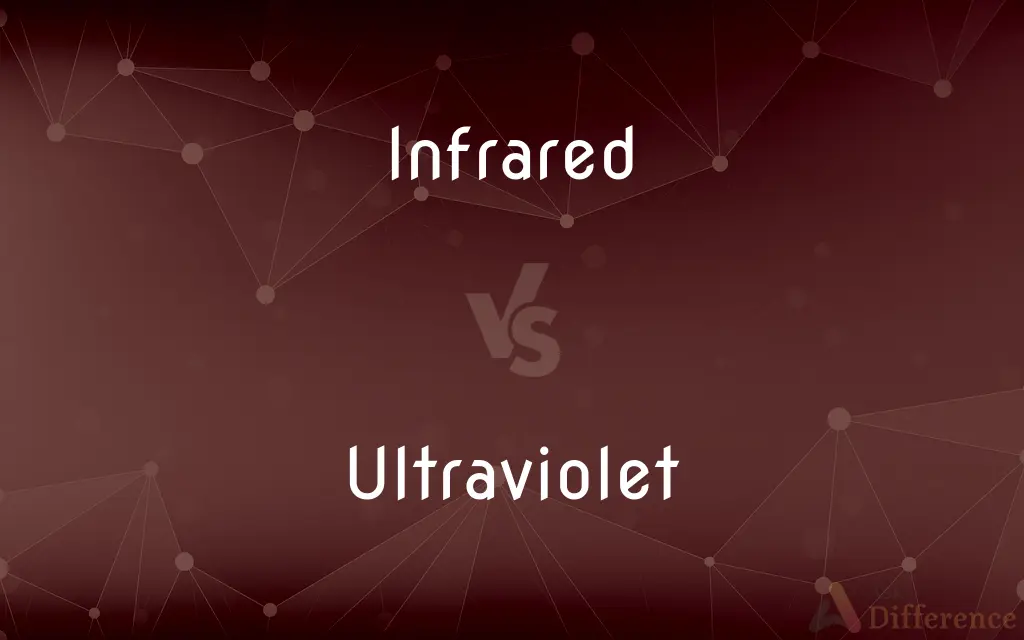Infrared vs. Ultraviolet — What's the Difference?
Edited by Tayyaba Rehman — By Fiza Rafique — Updated on April 30, 2024
Infrared light has longer wavelengths and is used for heating and night vision, while ultraviolet light has shorter wavelengths and is known for its germicidal properties and causing sunburn.

Difference Between Infrared and Ultraviolet
Table of Contents
ADVERTISEMENT
Key Differences
Infrared radiation exists just beyond the visible spectrum with longer wavelengths, commonly associated with heat as it is emitted by objects based on their temperature. Whereas, ultraviolet radiation occurs beyond the violet end of the visible light spectrum and is notable for higher energy photons which can cause chemical reactions, such as those leading to sunburn.
Infrared technology is widely used in thermal imaging and heating applications because of its ability to be absorbed and emitted by molecules as heat. On the other hand, ultraviolet light is often employed in sterilization processes and forensic analysis due to its ability to induce fluorescence and destroy microbial DNA.
The human body experiences infrared radiation as gentle radiant heat, which can penetrate deep into the tissues and is beneficial for therapy. Ultraviolet light, however, is generally not felt by the body but can lead to harmful effects such as skin cancer and cataracts with prolonged exposure.
Applications of infrared include everyday technologies like remote controls and security cameras, which utilize IR light for communication and imaging in low-light conditions. Ultraviolet light finds its application in medical and industrial fields, used in disinfecting water and air as well as in curing processes in dentistry and printing.
In terms of safety, infrared radiation poses minimal health risks, primarily potential thermal injuries from high intensities, such as from direct exposure to sunlight or fire. Ultraviolet radiation carries more significant risks, including severe skin burns, eye damage, and long-term mutations leading to cancer.
ADVERTISEMENT
Comparison Chart
Wavelength
Longer, typically >700 nm
Shorter, typically 10-400 nm
Common Uses
Heating, night vision
Sterilization, curing inks
Health Effects
Mostly safe, some heat risk
Can cause burns, cancer
Detection
Can be detected by sensors
Requires special equipment
Absorption
Mostly by water and plastics
Mostly by ozone and glass
Compare with Definitions
Infrared
Electromagnetic radiation with wavelengths longer than those of visible light, typically from 700 nm to 1 mm.
Infrared cameras are used for night vision since they can capture images based on heat emitted by objects.
Ultraviolet
Ultraviolet rays are responsible for causing sunburns.
Sunscreens are rated based on their effectiveness at blocking ultraviolet rays.
Infrared
Infrared saunas use IR radiation to heat the body directly without warming the air around you.
Infrared saunas are praised for their ability to provide a deep, penetrating warmth.
Ultraviolet
Ultraviolet astronomy explores celestial phenomena in UV wavelengths.
Ultraviolet telescopes are crucial for studying the sun and other stars.
Infrared
Infrared astronomy deals with the observation of celestial objects in infrared wavelengths.
Infrared telescopes can observe stars and galaxies hidden by cosmic dust.
Ultraviolet
Ultraviolet fluorescence is a method used in forensic science to detect substances invisible to the eye.
Forensic scientists use UV light to see blood traces at crime scenes.
Infrared
Heat emitted from the human body is mostly in the infrared spectrum.
Emergency services use infrared technology to locate persons in dark environments.
Ultraviolet
UV radiation is divided into three bands: UVA, UVB, and UVC, with UVC being the most harmful.
UVC light is used in air purification systems to neutralize airborne pathogens.
Infrared
Infrared is often used in communication devices like remote controls.
Many television remote controls use infrared signals to change channels.
Ultraviolet
A type of electromagnetic radiation with a wavelength shorter than that of visible light but longer than X-rays.
Ultraviolet light is used to sterilize surgical equipment.
Infrared
Infrared (IR), sometimes called infrared light, is electromagnetic radiation (EMR) with wavelengths longer than those of visible light. It is therefore invisible to the human eye.
Ultraviolet
Ultraviolet (UV) is a form of electromagnetic radiation with wavelength from 10 nm (with a corresponding frequency around 30 PHz) to 400 nm (750 THz), shorter than that of visible light, but longer than X-rays. UV radiation is present in sunlight, and constitutes about 10% of the total electromagnetic radiation output from the Sun.
Infrared
Of or relating to electromagnetic radiation between microwaves and red visible light in the electromagnetic spectrum, having frequencies between 300 gigahertz and 400 terahertz and wavelengths between 1 millimeter and 750 nanometers.
Ultraviolet
Of or relating to electromagnetic radiation between violet visible light and x-rays in the electromagnetic spectrum, having frequencies between 790 terahertz and 30 petahertz and wavelengths between 380 nanometers and 10 nanometers.
Infrared
Generating, using, or sensitive to infrared radiation.
Ultraviolet
Of or relating to a light bulb that emits ultraviolet radiation.
Infrared
Infrared light or the infrared part of the spectrum.
Ultraviolet
The ultraviolet range of electromagnetic radiation
Sunburns result from radiation in the ultraviolet.
Infrared
(uncountable) The electromagnetic radiation of a wavelength longer than visible light, but shorter than microwave radiation, having a wavelength between 700 nm and 1 mm.
Electromagnetic radiation
Ultraviolet
Of electromagnetic radiation beyond (higher in frequency than) light visible to the human eye; radiation with wavelengths from 380 nanometre - 10 nanometre
Infrared
(countable) A specific wavelength in this range.
Ultraviolet
Ultraviolet colour.
Infrared
(countable) A device that emits infrared radiation.
Ultraviolet
Lying outside the visible spectrum at its blue-violet end; - said of light more refrangible (i. e. having a shorter wavelength) than the extreme violet rays of the visible spectrum. Electromagnetic radiation with wavelengths shorter than those of ultrviolet light are not usually considered as light waves, but are classified differently. The ultraviolet region of the electromagnetic spectrum is generally considered as comprising those electromagnetic emissions with wavelengths lying between those of visible light and those of X-rays, i. e. between 4000 Angstroms and 100 Angstroms.
Infrared
Having a wavelength in the infrared spectrum.
Ultraviolet
Radiation lying in the ultraviolet range; wave lengths shorter than light but longer than X rays
Infrared
Lying outside the visible spectrum at its red end; - said of rays having a longer wavelength (and thus less refrangible) than the extreme red rays, specifically those electromagnetic waves having a wavelength of between 700 nanometers and 1 millimeter.
Ultraviolet
Having or employing wavelengths shorter than light but longer than X-rays; lying outside the visible spectrum at its violet end;
Ultraviolet radiation
An ultraviolet lamp
Infrared
Relating to, using, or producing infrared radiation.
Infrared
Affected by infrared radiation; as, infrared detector; infrared film.
Infrared
The infrared part of the electromagnetic spectrum; electromagnetic wave frequencies below the visible range;
They could sense radiation in the infrared
Infrared
Electromagnetic radiation with wavelengths longer than visible light but shorter than radio waves
Infrared
Having or employing wavelengths longer than light but shorter than radio waves; lying outside the visible spectrum at its red end;
Infrared radiation
Infrared photography
Common Curiosities
Can infrared light be seen by humans?
No, infrared light is beyond the visible spectrum and cannot be seen by human eyes, though it can be felt as heat.
Is exposure to infrared light harmful?
Prolonged exposure to intense infrared radiation can cause heat damage, but ordinary exposure, such as from household appliances, is generally safe.
What are common uses of ultraviolet light?
Ultraviolet light is commonly used for disinfection, curing of paints and resins, and in medical therapies.
What is the main difference between infrared and ultraviolet light?
Infrared light has longer wavelengths and is primarily associated with heat, whereas ultraviolet light, with shorter wavelengths, is known for its energy capable of causing chemical reactions and damage to living tissues.
Why is ultraviolet radiation considered dangerous?
Ultraviolet radiation can cause skin damage, eye injuries, and contribute to skin cancer due to its high energy photons that can penetrate tissues and damage DNA.
What is the role of ultraviolet light in water purification?
Ultraviolet light can kill or inactivate microorganisms by damaging their DNA, making it a chemical-free method to purify drinking water.
How do infrared heaters work?
Infrared heaters emit infrared radiation that directly heats objects and people in its path without warming the air, making them efficient for targeted heating.
How do animals use infrared radiation?
Some animals, like snakes, have organs that detect infrared radiation, helping them to sense warm-blooded prey even in complete darkness.
What precautions should be taken when exposed to ultraviolet light?
Protective clothing, sunglasses, and sunscreen are recommended to guard against the harmful effects of UV radiation, particularly if one is outdoors or exposed to artificial UV sources for extended periods.
What is the difference between near, mid, and far infrared?
Near-infrared (NIR) has the shortest wavelengths and is closest to visible light, mid-infrared (MIR) is used primarily for sensing applications, and far-infrared (FIR) is used for thermal detection and imaging.
How is infrared used in communication systems?
Infrared is used in communication systems such as remote controls for TVs and other devices, where IR LEDs emit light that is modulated to carry information to a receiver.
Can infrared technology be used in healthcare?
Yes, infrared technology is used in healthcare for various diagnostic (like thermography for detecting inflammation) and therapeutic purposes (such as infrared therapy to improve circulation).
How does ultraviolet light affect plants?
Ultraviolet light can have both beneficial and harmful effects on plants; it can hinder growth by damaging DNA and proteins, but also plays a role in plant morphology and chemical production.
What is the significance of the ozone layer in relation to ultraviolet light?
The ozone layer in Earth’s atmosphere absorbs and scatters the majority of the sun’s harmful ultraviolet radiation, particularly the most dangerous UVB and UVC rays, protecting living organisms.
Are there any materials that block ultraviolet light?
Materials like window glass, certain plastics, and clothing treated with UV-blocking substances can effectively prevent ultraviolet light from passing through.
Share Your Discovery

Previous Comparison
Tequila vs. Vodka
Next Comparison
Sanction vs. EmbargoAuthor Spotlight
Written by
Fiza RafiqueFiza Rafique is a skilled content writer at AskDifference.com, where she meticulously refines and enhances written pieces. Drawing from her vast editorial expertise, Fiza ensures clarity, accuracy, and precision in every article. Passionate about language, she continually seeks to elevate the quality of content for readers worldwide.
Edited by
Tayyaba RehmanTayyaba Rehman is a distinguished writer, currently serving as a primary contributor to askdifference.com. As a researcher in semantics and etymology, Tayyaba's passion for the complexity of languages and their distinctions has found a perfect home on the platform. Tayyaba delves into the intricacies of language, distinguishing between commonly confused words and phrases, thereby providing clarity for readers worldwide.
















































